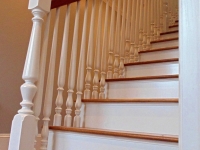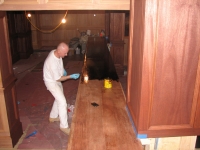How much area will one gallon of paint cover?
For many paints, one gallon will cover 400 square feet. However, the quality of the paint can affect how much it will cover. The label on the paint can usually provides some guidance. In addition, there are a number of factors that affect how much paint you will need. These include the type of surface being covered, the color currently on the surface and the color being applied.
How do I recognize a good paint?
Paint has three components: the binder, the pigment and the liquid. The best paints contain a higher volume of solid materials. Pay close attention to the solid content. For example, a $13 gallon of paint with a solid content of 19 percent might cover about 200 square feet, while a $20 gallon of paint with 41 percent solid content will cover about twice that amount. The binder is the most important factor in the durability. Some paints also have additives to enhance their performance, such as mildewcide.
What are the advantages of latex paint?
In addition to being thinnable with water, latex paints feature:
- Less odor
- Water cleanup
- Non-flammable
- Faster drying
- Ease of touch up
- Ease of application
- Better gloss
- Less fading on exteriors
- No yellowing on interiors
- Less likely to crack or peel
What is an oil-based paint?
These paints have resins and thinners in them that evaporate when the paint dries. This process forms a hard coating and provides heavier coverage on the first coat, effective penetration and excellent adhesion. They are particularly good for chalky surfaces and those that already have several layers of oil-based paint.
What does the term gloss mean?
It refers to how shiny the paint is. Manufacturers use terms such as flat, satin, semi-gloss and high-gloss to describe their paints, but there are no specific industry standards.
What type of paint should I use in my kitchen?
High-gloss paints are great for high-traffic areas because they provide a tough, washable finish that also resists water and grease. Use them on kitchen and bathroom walls, kitchen cabinets, banisters and railings, trim, furniture, doorjambs and windowsills. However, the gloss will make surface imperfections more noticeable, so you will have to work a little harder to ensure a good finish. A semi-gloss provides a little less durability but is a little easier to work with.
Where should I use a flat paint?
These are also called matte finishes and they are good for walls and ceilings in lower-traffic areas.
What is an eggshell finish?
It’s a paint that has a little more sheen than a flat paint, which makes it easier to clean and gives it a more lustrous appearance. It can be used in place of semi-gloss to provide a less shiny finish. Some manufacturers market a satin or silk finish, which is usually a little shinier than an eggshell but less shiny than a semi-gloss.
What is the advantage of a natural-bristle brush?
Bristle has naturally split ends called flags, which help hold the paint in the brush so that it is released throughout the stroke instead of all at once.
Should I use a natural bristle brush with a latex paint?
No. Just remember that humid weather can make someone’s hair turn frizzy. Water-based paints do the same thing to natural-bristle brushes, so you will want to use a synthetic brush with latex paint.
What type of brush works best with oil-based paint?
Natural bristles are best for most oil-based finishes including varnishes and stains. Their soft tips leave fewer brush marks.
Should I buy a paint brush with angled bristles or cut square?
An angle-tipped brush allows you to put the tips of the bristles on the work at the natural angle that the brush is held. In addition, an angle-tipped brush puts slightly more bristle area on the work than a square-tipped brush of the same width.
Can I use the same brush for both latex and oil-based paint?
Yes, but you must make sure you clean them extremely well. It’s best if you just buy two sets of brushes-one for latex and one for oil-based paints.
What type of brush is best for rough surfaces?
A synthetic brush is your best choice, because the rough surface can quickly damage the flags on a natural-bristle brush.
How wide of a brush should I use?
The best answer is whatever you feel comfortable with. A bigger brush holds more paint and applies it more quickly, but it is also harder to control.
How do I choose the right roller cover?
Roller covers vary in pile or nap length, and it’s essential to choose the right pile length for the surface texture you’re painting. A general guideline is:
- Smooth (3/16″ or 1/4″ nap): for walls, floors, and fine finishing.
- Medium (3/8″ or 1/2″ nap): for sand-textured walls.
- Rough (3/4″ or 1″ nap): for light stucco walls and masonry floors.
- Extra Rough (1 1/4″ nap): for brick, block, masonry and stucco.
Should I use a different type of roller cover for oil-based paint and latex paint?
Yes, just as you would with a paint brush. Natural fiber roller covers made with mohair or a blend of polyester and lamb’s wool are usually recommended for oil-based paints, varnishes and stains. Synthetic fiber roller covers, on the other hand, are most often recommended for applying latex paints.
What are the quality features in a good roller?
Good roller frames have a compression-type cage, which is also convenient, because their covers can be removed quickly and easily. Also, look for a handle that has a threaded end so you can use an extension pole for painting floors and ceilings.
How do I know which caulk or sealant to buy?
This depends on a variety of factors:
- Where will the sealant be applied?
- What type of surfaces will be bonded or caulked?
- How much stress or movement will the joint be subject to?
- What other performance requirements will it need to meet?
What kind of caulk should I use around window frames?
Latex caulks are good for filling these kinds of gaps. They clean up with water and most are paintable. However, they must be applied in temperatures of more than 40 degrees Farenheit.
Do I need to apply anything to the wall before papering?
You should apply wall sizing to all walls. It prepares the surface and acts as a first coat. It makes a smooth surface and prevents paste from soaking into the wall.
What tools do I need to remove old wallpaper?
A wallpaper remover, a 3″ wallpaper stripping tool, a bucket and a sponge. You can also buy a tool that will score the paper before you apply the remover.
What is the difference between a wood stain and a varnish?
A wood stain is used to change the appearance of the wood, such as to bring out the definition in the wood grain or match the look of another species of wood. Varnish, which may be water- or oil-based, provides a clear, transparent coating that is durable and hard. Varnishes also come in a variety of shines from flat to high gloss, and they may be water or oil based.
What is the difference between solid-color and semi-transparent stains?
Semi-transparent stains provide a color to the wood, but still allow the texture and natural grain to show through. Solid-color stains allow the texture to show, but not the grain.
I’m going to be painting a table that has a gloss finish. Do I need to prepare the surface?
You should use a liquid deglosser, which works without sanding and produces a slight tack for better adhesion of the new finish.
What can I use to thin epoxy?
Use acetone. It will soften most paints and plastics, so you must exercise caution when you are using it. Acetone is the active ingredient in many paint strippers.
I have some loose shingles. Is there anything I can do to prevent leaks without replacing those shingles?
Fibered plastic roof cement, which comes in caulk tubes, quarts, gallons and 5-gallons containers, can be used to seal down shingles and seal flashings.
What’s the difference between roof cement and roof coating?
The cement has to be put on with a trowel, while the coating is brushed on.
How do I tell which steel wool is finer?
The smaller the number, the finer the steel wool.
What can be used to produce a nice, smooth surface when I finish furniture?
Using a fine steel wool between multiple coats will give you a smoother surface. Be sure to clean the surface with a tack cloth before painting each additional coat.
How does a sandpaper holder help me sand?
A sanding block helps speed up sanding jobs, relieves strain on your hands and makes your sandpaper last longer.
I want to sand several chair legs, but I’m having difficulty because of the contours and hard-to-reach areas. Can you help me?
Try a flexible sanding sponge.
What does a number such as 120 on sandpaper mean?
These numbers stand for the number of particles per square inch. The higher the number, the finer the sandpaper.
Is sandpaper better than steel wool for smoothing finishes between?
It can be just a matter of preference, but steel wool is normally recommended. You might also want to consider a finishing pad. They don’t shed or rust like steel wool, and they can be rinsed and reused. They’re available for wood, metal and stripping.
Are there different kinds of latex caulk?
Yes. For example, vinyl latex is good for small cracks. Acrylic latex is a little more flexible and lasts longer, up to 10 or 15 years. Siliconized acrylic latex should not be confused with a pure silicone caulk. It is a medium-performance caulk that provides some water resistance and lasts up to 25 years or more.
How many coats of varnish do I need to apply?
Generally, from two to four coats, applied in thin layers.
What’s the best way to apply varnish?
The best type of room is one that is not too humid and is about 70 to 75 degrees. To protect against debris from getting onto the finished piece, the room should be free from dust. You might even consider mopping the room or covering the floor with paper. Make sure that the surface to be varnished is clean, dry and free of any finishes. Try to have the piece horizontal. In addition, to mix the varnish, stir it. Don’t shake it because air bubbles can get into your finished piece.
Denatured alcohol, which can also be used in many shellac based products.
What is a tack cloth?
It’s a cloth that picks up and holds dirt, sand and other debris. You should use one on any surface before you apply a coat of paint or any other finish.



